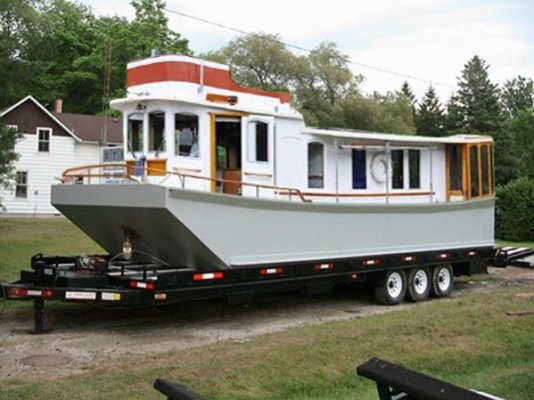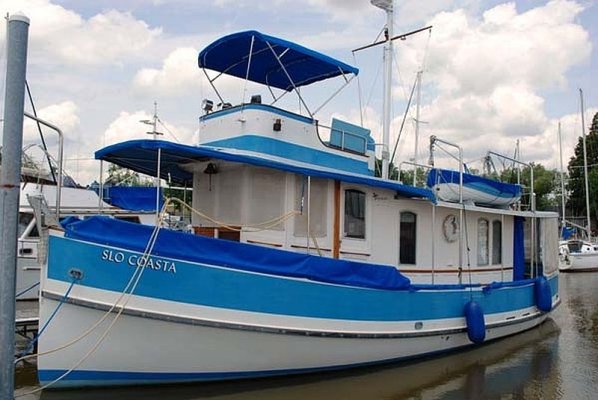We will get back to 'building' that redesigned Pilgrim vessel (more superstructure ideas) a little later in this subject thread.
Meantime its Labor Day weekend and I will be taking a long trip back from Thailand (half way around the world) to DC, and then down to the ocean for a reunion dinner. So I will be out of touch for a while.
I was looking thru some of the material I had collected on this Pilgrim design, and ran across this 'blog' that a gentleman wrote about his and his wife's experience with choosing and buying a Pilgrim for themselves. Thought some might find it interesting.
Thoughts on Buying a Trawler:
[FONT=Arial,Arial][FONT=Arial,Arial]In today’s (2011) economy, I expect that it is quite easy to buy a Pilgrim, and not so easy to sell one; just like any other boat. [/FONT]
[FONT=Arial,Arial]Trawlers have always been expensive. In Mike Andersons (well written) blog on Cruising Cleo, he notes that the January, 1987 price of CLEO (#34) was $187,475 + $33,820 in options, for a total of $221,295 + tax (I presume). Since CLEO has a flybridge, I expect a good chunk of the option package was to pay for that singular item. FYI: This translates to $441,072 according to an on-line CPI calculator. Unfortunately, todays buyer expects a more refined product, driving up the price even further. [/FONT]
[FONT=Arial,Arial]In 1988, starting with hull #38 Gozzard made some changes to the boat, raising the foredeck and adding the raised fiberglass bulwark in the bow among other things. Changes to tooling need to be paid for so I expect the last eight boats cost more than CLEO. Nobody has offered up any information on what they originally paid for their boat when new, and I haven’t been cheeky enough to ask. [/FONT]
[FONT=Arial,Arial]Others have noted what the current asking prices are, as found on Yachtworld or other brokerage sites. In reality, if you are working with a broker that advertises on Yachtworld, they can produce a report that indicates what the asking price was and the final sales price for a class (brand) of boats. We did this when we were purchasing LIBERTY, not that it made any difference one way or another. [/FONT]
[FONT=Arial,Arial]Our Buying Story: [/FONT]
[FONT=Arial,Arial]We realized we needed a bigger boat in late 2008. I had poured a ton of time and money into the rebuild of a 30’ double ended, Finnish built trawler. This was to be our "last" boat so the time and money was no object. Time marches on, priorities change and events in our lives made us realize we weren’t going to live forever. My wife has always wanted to live aboard a boat and do some serious cruising and we realized that 30’ is just too small for that. [/FONT]
[FONT=Arial,Arial]As we are approaching early retirement age, and are not exactly independently wealthy, we realized that to make this dream happen, we would have to purchase a boat at a price that we could afford. [/FONT]
[FONT=Arial,Arial]In the 40’ range, this probably means an older boat. An older boat usually needs some work. We knew the sooner we bought the older boat, the more time we would have to fix its probably many ills and the cheaper it would be, affording us a bigger boat than if we waited until the last minute and tried to purchase a boat that is "cruise ready" if there is such a thing. [/FONT]
[FONT=Arial,Arial]Many of you are probably in or have been in the same boat. [/FONT]
[FONT=Arial,Arial]Buying LIBERTY was easy. Well, in the end it was easy. I had been dragged to a number of yards to look at trawlers for one of my buddies who was making the switch from sail to trawlers. Since I have been known to rain on people’s parades, he thought I would be a good person to have along since I seem to be able to point out issues and have a good idea on what it would take to correct the problem. So maybe I dampen the parade a bit. This was great experience, as we looked at boats that I wouldn’t have given a second thought and learned a little from each one. [/FONT]
[FONT=Arial,Arial]When it came time to find a boat for ourselves, I had a prioritized list. Boat deck (no more davits off the stern), one main stateroom (no chopped up interior with tiny cabins for seldom seen guests) etc. I started to spend many hours perusing the internet, looking for the ideal craft for us, seeing how well they matched our list. [/FONT]
[FONT=Arial,Arial]Every time I came across a reference to a brand I didn’t recognize, another search was done to see if the boat might meet our requirements. After a while I thought I had exhausted the list of boats that had produced and we started to look at the very few brands that made the short list. We were well into 2009 and June of 2014 (our projected retirement date) was looming right around the corner. Nothing had caught our fancy. We had been eyeballing Krogen 42’s from afar and while somewhat pricy, thought we should give them a look close up and personal. At the same time I came across a rather obscure reference to a Pilgrim. Pilgrim; never heard of one, what is that? While we are generally traditionalists as far as boats go, the Pilgrim seemed a bit "out there". They reminded us somewhat of turn of the century fish tugs that used to ply Lake Erie, back when Erie, PA was the largest freshwater fishing port in the world. So the shape and profile wasn’t necessarily a bad thing, but Pilgrims were different. Of course our 30’ Finnish built trawler was also a duck-out-of-water on Lake Erie, so we can live with "different". [/FONT]
[FONT=Arial,Arial]In 2009, there were about 40 Krogen 42’s for sale; about 10% of the total number built. There were about 4 Pilgrims for sale, roughly about 10% of the total number built. That meant a lot of choices if you want a used Krogen, not so many choices for a Pilgrim. [/FONT]
[FONT=Arial,Arial]We scheduled a trip to Annapolis in early October of 2009 to look at a Krogen 42, and a Pilgrim. This would be the final boat viewing trip of the year. After that it would be back to doing internet searches for the winter. [/FONT]
[FONT=Arial,Arial]We saw the Krogen first. BIG Boat. Now I knew where that 40,000 lb displacement was when viewing the boat out of the water. She had active fins, 12,000 hours on the engine and came with a sizable price tag. She also had some issues that were beginning to surface, like any 20+ year boat would have. The problem was that she was built more for the ocean, and I am not fond of long passages out of sight of land. Being built for the ocean also meant that when things needed rebuilt or replaced, there was a lot of material and labor involved. The inside was a lot more cramped then we expected. [/FONT]
[FONT=Arial,Arial]Off to see the Pilgrim. The Pilgrim is not built for long passages on the ocean; that we knew. As a coastal cruiser, she appeared neither over built nor under built, and had a somewhat delicate look to her. We are a fan of L. Francis Herreshoff and once had a 29’ double ended ketch designed by him. She was built of wood, exactly to the specifications laid out by Herreshoff and while also fairly delicate looking, was engineered to have the strength necessary for her intended use. Things do not need to be massive or overbuilt by a factor of 10. That just means that something else will fail first. [/FONT]
[FONT=Arial,Arial]Back to the Pilgrim. We did a quick walkthrough. If we don’t like what we see at first glance, there is no use wasting our time and the broker or owners time. Actually, we did like what we saw. My wife looked at me and said, "this is the boat"; and so it was. Well maybe not that particular Pilgrim, but some Pilgrim. I thought I had made it clear to the broker that if we liked the boat I was going to go over it with a fine tooth comb. He thought I was going to have it surveyed by someone else at a later date as he had other appointments. I finally made it clear to him that this "was the survey". Since he couldn’t just leave me there for the rest of the day alone (brokerage rules) he needed to call the owner to see if it would be ok for me to be there without him. As the boat had been on the market all summer with no offers, the owner thought "why not?". [/FONT]
[FONT=Arial,Arial]After doing our hull survey it was time to check out the interior. She was rough and in need of some TLC. That was a good thing. I could see why there had been no offers made. Since I seem to tear everything up anyway, it didn’t bother me that she needed work. The previous owner had the engine and bow thruster replaced a few years prior, and the engine only had about 400 hours on it but a lot of people don’t look at that. This means the big stuff is sort of done; I can do the rest. Sure we found some issues, but nothing that we couldn’t do given some time and money. Maybe this is the Pilgrim for us. [/FONT]
[FONT=Arial,Arial]At the end of the day, we decided that we would make an offer but wanted to spend a day or so thinking over what our offering price should be. We would do this from home, a seven hour drive away. This keeps you from doing something silly as buying a boat is really an emotional decision. A sound financial investment, it is not. Since we were there alone, we had a glass of Charles Shaw (aka Two-Buck-Chuck) on the Pilgrim and toasted our good fortune in actually finding a boat that will hopefully allow us to fulfill our dream, locked up the boat and said goodbye to what we hoped would be our new family member. [/FONT]
[FONT=Arial,Arial]As I said earlier, buying LIBERTY was easy. The previous owner wanted out. He was getting out of boating, period. We wanted in. Negotiations went quickly and smoothly and we both ended up happy, or at least we were happy. Now the real fun begins.[/FONT]
Thoughts on Selling a Trawler:
(you can read the remainder of this story on the attached PDF)[/FONT]










